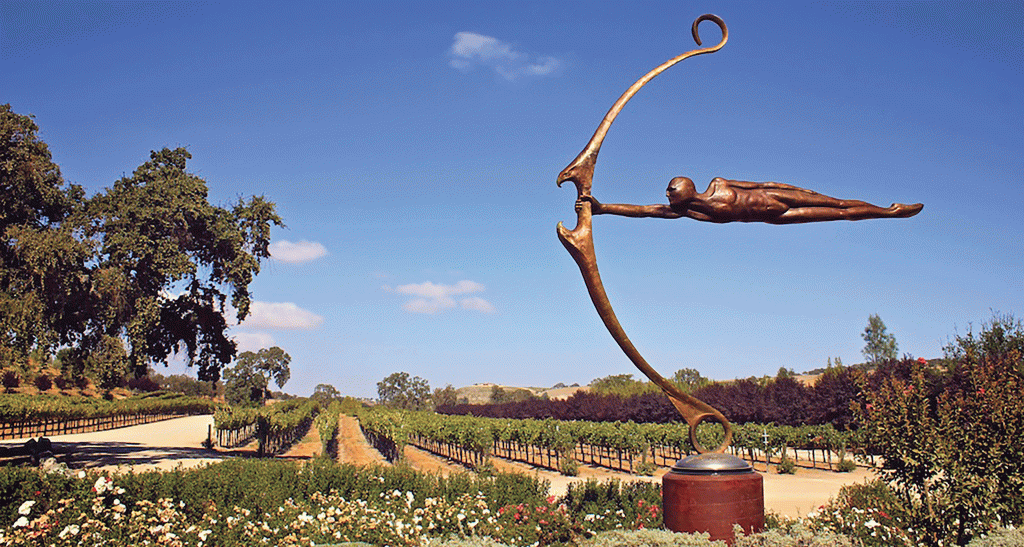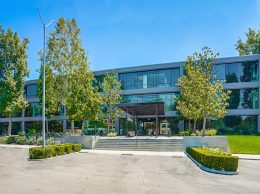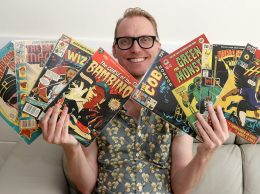Sculpture garden draws visitors to Paso Robles winery

“Mega Focus” is a bronze sculpture by Dale Evers showing a human form poised to be launched from a bow at the Sculpterra Winery.
If they didn’t serve wine at Sculpterra Winery’s estate tasting room, it still would be an interesting place to visit.
The venue on Paso Robles’ east side is nestled in a verdant garden where meandering paved walkways, hedges and plantings frame dramatically large, museum-quality sculptures.
There are stylized renderings of animals — horses, alley cats, big cats, a mammoth — in bronze or granite by the late sculptor John Jagger. More recent works in metal and glass by Dale Evers include his iconic “Mega Focus,” a dramatic 24-foot-high bronze sculpture of a human form in the shape of an arrow poised to launch from a bow.
Resident blacksmith and sculptor Robert Bentley crafted elegantly detailed iron chandeliers for the tasting room, the ornate front gate and decorative embellishments throughout the property. The tasting room is an art gallery filled with paintings by a rotating group of guest artists whose works are sold on consignment.
All that art plays a big role in attracting visitors to Sculpterra Winery and Sculpture Garden, which is off the beaten path in a rural area off a twisting back road in the Linne Valley, about five miles east of downtown Paso Robles.
The art “really sets us apart as a destination,” vineyard manager and winemaker Paul Frankel said in an interview at the sculpture garden. “We get lots of people who don’t like wine, don’t taste wine. They just want to see the art and they end up buying wine or they end up telling their friends, and they join our wine club.”
Paul is the son of Dr. Warren Frankel, a physician who in 1989 moved his family and practice from Los Angeles County to Paso Robles, where he had purchased ranch property 10 years earlier. He first planted pistachio trees on the land and, in 1993, he began planting wine grapes, starting with cabernet sauvignon and later adding merlot and zinfandel.
From 1995 to 2005, he sold grapes to other wineries. The idea of making wine, opening a tasting room and creating a showcase for art came together in 2005, when Dr. Frankel met sculptor John Jagger at Atascadero Bible Church, where Jagger was attending the doctor’s Bible class.
Jagger was an accomplished sculptor in his 80s who had done projects in New York, Las Vegas, Chicago and Europe.
One Sunday after church, Jagger invited the elder Frankel to his home in Arroyo Grande to see some of his creations. His father decided that year to hold back some of the vineyard fruit for making their own wine, Paul Frankel said. Paul, a teen-ager at the time, went with his dad and recalls seeing the house filled with miniature sculptures that could be scaled up to much larger pieces.
“And I don’t know if was John’s idea or my dad’s idea. I think it happened at the same time where they both decided, hey, this would be a great effort if, John, you made sculptures and we opened a tasting room on our property,” Paul said.
Jagger began creating super-sized versions of his miniatures — a 20,000-pound granite puma, a 30-foot tall bronze bucking horse — while tasting room construction got under way. The sculptor worked on commission for five years, paid by Sculpterra for his time and materials. He drew up a scheme for the garden and joined with Atascadero-based landscaper Les Toma in developing it. Jagger, who died in 2013, saw this as the culmination of his life’s work, Paul Frankel said.
Jagger had many of the pieces ready and on site when the tasting room opened in October of 2007. It took a year or two for word to spread about the venue, and then things took off, Paul Frankel said. “So this has become a place to come in the area. Lots of locals, if they have a family member from out of town come or they have guests visiting, they have to bring them here,” he said.
Sculpterra Winery grew from 1,500 cases to 15,000 cases a year over eight years. Plans are to eventually produce 30,000 cases, all from estate fruit, Paul Frankel said.
Other artists have added their talents to the garden. Dale Evers, a former student of Jagger’s, created works in glass, steel and bronze with themes from nature: butterflies, fish, dragonflies, and his signature “Mega Focus.” Steven Kayler created an art wall at one edge of the garden that depicts the history of winemaking in California from the conquistadors and missions to Paso Robles pioneers. A new section will cover the growth of Paso as a wine region to the present day.
Some of Jagger’s original small sculptures are on sale in the tasting room at prices from $3,000 to $12,000, as are $30 replicas made from molds. Also offered are bronze replicas of Evers’ “Mega Focus” in three sizes.
The art is not the only notable thing about Sculpterra. Part of the proceeds from wine sales go to support a medical missionary group called His Helping Hands, co-founded by Dr. Frankel. At age 74, he continues his family practice and makes trips around the globe with a team of doctors, nurses, a paramedic and a pharmacist to bring medical care to those in dire need. Among countries visited recently are Ethiopia, India and Peru.
Since 2010, the winery has been producing an alternate label of its estate wines called Héroe (pronounced ERR-oh-way, Spanish for hero) that honors its vineyard and cellar workers. Labels on the bottles show the faces and names of the entire season’s crew.
Cabernet sauvignon is the most planted variety in the vineyard at 100 acres and is one of the top- selling red wines, just behind primitivo, an Italian grape closely related to zinfandel, Frankel said. He makes 20 wines from 12 grape varieties on the property. Among the later varieties planted are Rhone grapes, viognier, grenache, syrah and mourvedre, made into single varietals and blends. The top-priced wine is Bentley Ironworks Cabernet Sauvignon ($60), grown in Sculpterra’s Bentley Ironworks Vineyard that produces cab with the best character every year, Paul Frankel said.
The younger Frankel, who studied at Cal Poly San Luis Obispo with a double concentration in viticulture and enology, said his father has been a risk taker in the business.
The family went against conventional thinking in 2005 by deciding to grow delicate pinot noir grapes, high in demand, in seasonally hot Paso Robles. Pinot was grafted onto a block of original cabernet sauvignon roots.
“We took another risk, thinking that, hey, if we grow pinot, we can sell it for a lot of money because it’s worth $2,000 or $3,000 a ton when it’s grown right,” Paul said. “Why don’t we try it?”
The pinot noir is located in a protected block at lower elevation, shaded by hillsides from the afternoon sun. Leaves are pulled from the morning side of the canopy to give it sun exposure and they are kept full on the afternoon side to shade the fruit. Paul Frankel said he prunes pinot noir late in the spring so bud breaks late and he harvests early for a shorter growing season. Pinot is picked in predawn hours and fermented cold. In hot periods, the grape benefits from daily temperature swings that can be as great as 50 degrees.
“The first year I made (pinot noir) was 2008,” Paul Frankel said. “I just did 100 cases and people were surprised when we poured it in the tasting room and everyone loved it. We sold out. Now I’m making about 1,000 cases a year with both of the labels that we make.”
It’s not a coastal pinot noir, he said. “It has different expressions of fruit and mouth feel, different characteristics, but it’s truly a delightful wine.”
The Héroe label had its beginnings in 2010, when Paul Frankel made a barrel of wine for the workers. Each received a case of wine. When it came time to put labels on the bottles, crew members didn’t know what kind of look they wanted, he said.
Paul Frankel took a photo of a longtime worker at Sculpterra who was retiring that year. He became the face of the label, appearing on the front each year. All of a season’s worker’s faces and names are on the back label. “These are the people who don’t get recognized for all their work behind the scenes,” he said.
Héroe wines — viognier, pinot noir, primitivo and cabernet — are sold outside the tasting room at select stores in the area including Costco, Vons, Smart and Final and Food for Less.
The sculpture garden is something that will continue evolving.
“We don’t want just to be known as a winery, we want to be known as an art gallery, as a museum of sorts, definitely,” Paul Frankel said. “And we keep adding more and more art to this place. We really want it to be off-the-charts beautiful.”
• Contact Tom Bronzini at [email protected].











